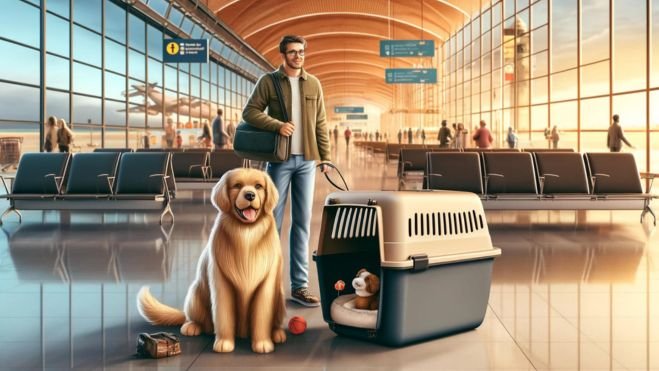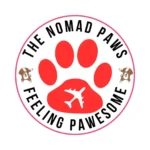Traveling with a nervous dog can be an intense experience, right? But trust me, you can handle it.
Over the years, Debbie and I have found that understanding your pet’s anxiety triggers and preparing in advance can make a big difference.
We once had a dog who was terrified of her carrier at first, but we gradually got her used to it.
We used treats and praise to turn it into a safe haven for her, which really helped during the flight.
We’ve also found that getting our dogs used to the hustle and bustle of the airport ahead of time can be a game-changer.
Controlled exposure to these kinds of travel stimuli, like the sounds and movement of luggage, can help to desensitize them and reduce their stress.
One thing we’ve discovered that works wonders is maintaining a consistent routine before the flight.
We make sure our dogs get plenty of mental and physical exercise to keep their stress levels low.
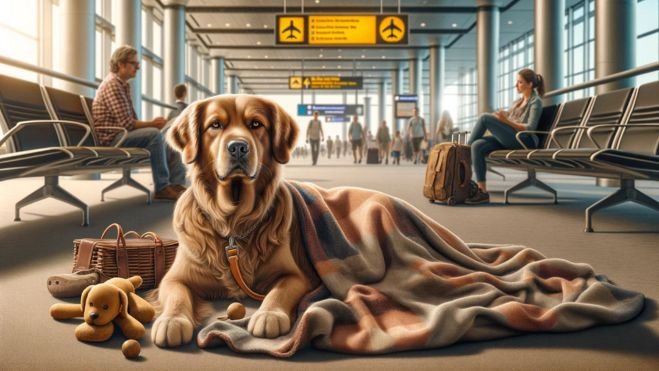
On one particular trip, we had a layover in a busy airport. Our dog was remarkably calm, and we believe it was due to the long walk and playtime we had prior to our journey.
During the flight, we always bring along comforting items. It’s amazing how a familiar blanket or their favorite chew toy can soothe them.
On a recent trip, we noticed that our dog seemed a bit anxious, so we gave him his favorite blanket. He immediately snuggled up and calmed down.
And if necessary, we’ve found that natural calming aids can be beneficial. But remember, it’s crucial to discuss these aids with your vet and test them beforehand to ensure they don’t have any adverse effects on your pup.
If you’re looking for additional ways to ease your dog’s travel anxiety, you can learn how to calm your dog during travel with Adaptil Transport spray.
Traveling with your dog can be a joy if you’re prepared. It’s all about understanding their needs and making the journey as comfortable as possible for them.
This is what this article is for.
Understanding Dog Anxiety During Travel
When I get ready to fly with my dog, I always try to understand what might make them anxious during the trip.
It’s super important to keep an eye out for signs that your dog is feeling stressed, like if they’re panting a lot, trembling, or whining.
By noticing these signs early, you can help your furry friend feel more comfortable throughout the whole travel experience.
Need an example?
On one trip, my dog started panting and whining as soon as we got to the airport. I realized he was getting overwhelmed, so I made sure to find a quiet spot to calm him down.
It really helped make the rest of the journey smoother for both of us.
Little things like this can make a big difference in how your dog handles travel.
Common Causes of Travel Anxiety in Dogs
I’ve traveled with my dogs a lot, so I get how anxious they can be during trips.
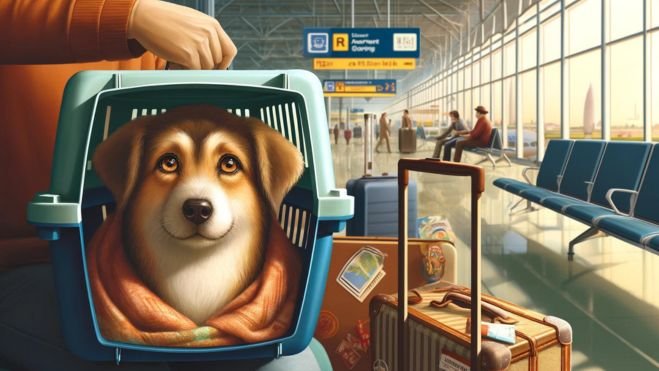
There are a few common things that can make your dog nervous when you travel. For starters, new places can be scary. Imagine being somewhere totally unfamiliar – it’s the same for dogs.
Also, being separated from you can make them feel uneasy. They love being close to their humans!
Another biggie is motion sickness. Yep, dogs can get it too, just like us. And if they’ve had bad experiences with travel before, like a rough flight or a bumpy car ride, they might associate travel with those bad memories.
Knowing these things can really help you make your dog feel safer and more comfortable when you travel. You can plan ahead, bring along their favorite toys, or maybe even talk to your vet about ways to ease their anxiety.
Recognizing Signs of Anxiety in Dogs
When I travel with my dog, I always keep an eye out for signs of anxiety. It’s really important to notice both physical symptoms and changes in behavior.
For example, if my dog is panting a lot, drooling, or trembling, those are clear signs she’s feeling anxious. Behavior-wise, she might try to hide, cower, pace around, or even try to escape from her carrier.
By knowing what to look for, I can help make her feel more comfortable and ensure our trip goes smoothly. It’s all about making sure she feels safe and relaxed.
Behavioral Changes
Noticing changes in your dog’s behavior is really important for spotting anxiety during flights. Look for signs like pacing, whining, or shaking. Sometimes, your dog might even try to escape their carrier.
From my experience, you can help calm them down by using special sprays that mimic natural calming scents or snug-fitting shirts designed to make them feel secure. These tricks can make a huge difference in making air travel less stressful for your furry friend.
Preparing Your Dog for a Calm Flight

Getting your dog ready for a calm flight needs to be your ultimate goal. First, I always start with crate training way before the trip. This helps my dog get used to their travel carrier, and it’s like their little safe space.
I also try to get them used to different travel sounds, like the roar of an airplane or the busy noise of an airport. This way, when we’re actually traveling, it’s not all new and scary for them.
Sticking to their exercise routine is super important too. Keeping their schedule consistent helps keep their stress levels down. I’ve noticed my dog is way more relaxed when we’ve kept up with our usual walks and playtime before a flight.
Let’s see how these steps can help make travels smoother and more enjoyable for you and your furry pal.
Crate Training and Acclimation
When I started traveling with my dog, I quickly learned that crate training and acclimation are super important for a smooth flight.
Picking the right crate size is key.
Make sure your dog can stand, turn around, and lie down comfortably in it. This makes a huge difference in their comfort and calmness.
To make the crate a happy place, I introduced it slowly. At first, I left it open in the living room and tossed in some treats and their favorite toys.
Over time, I noticed my dog would go in there on their own, even without any treats.
I started by closing the crate door for just a few minutes at a time, rewarding my dog with treats and lots of praise when they stayed calm. Then, I slowly increased the duration. This helped my dog get used to being inside without feeling stressed.
Praising them and making it a positive experience really helped too.
This way, when it came time to fly, the crate wasn’t something scary or new; it was just another comfy spot they were used to.
Exercise and Routine Before Travel

Before a flight, I always make sure to give my dog plenty of mental and physical activity. This really helps keep them calm during the trip.
I’ve found that playing interactive games like fetch or tug-of-war works wonders. It helps burn off their extra energy and eases their anxiety.
I also ike to play with interactive toys and puzzles, and we do some training exercises to tire him out both mentally and physically.
Another thing I do is stick to my dog’s regular routine as much as possible. Keeping their feeding times and potty breaks consistent helps them feel secure and familiar, even when everything else is changing.
Sticking to your dog’s usual exercise and feeding routines in the days before a flight can really help them feel more secure and relaxed while traveling.
Keeping a consistent schedule, like regular walks to release energy and reduce stress, plus familiar feeding and potty times, gives your dog a sense of security.
Natural Methods for Calming Your Dog
One thing I notice lots of people rely on are calming pheromone products, like collars or sprays. They mimic the scent of a mother dog, which can really soothe your pup’s anxiety.
In my experience, these products don’t work like magic, but they definitely help. My dog seems to be more relaxed and less anxious, which makes the whole travel experience smoother for both of us.
If you’re worried about your dog getting anxious on a plane, I’d definitely recommend chatting about calming collars or sprays with your vet.
They’ve worked well for a lot of dogs and, if your vet tells you they can be used on your pup, they can make the whole travel experience much more pleasant for both you and your furry friend.
Pressure Wraps and Thundershirts
Another great option is using pressure wraps or Thundershirts, a non-medicinal way to keep your dog calm and comfortable during flights. These accessories give a gentle, constant pressure that helps your dog feel secure.
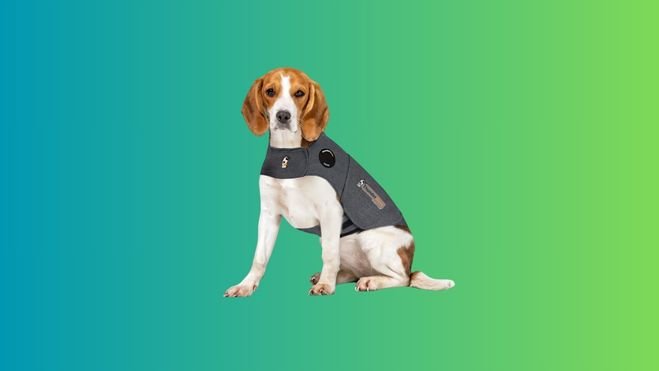
From my experience, these wraps can really help anxious dogs feel more secure and relaxed in many situations when the pup is at risk of separation anxiety. Veterinarians often recommend them because they provide a sense of safety without needing any meds.
The gentle pressure helps to ease your dog’s stress. Just remember, while they’re quite effective, they aren’t a magic fix for all dogs. Some pups might need a little extra help or time to get used to the wrap.
If you plan to use something like a Thundershirt, making sure it fits right is super important. You want it snug but not too tight.
There’s usually a sizing chart you can follow, and I’ve found it pretty accurate. Once you get the fit just right, it can really help reduce your dog’s stress without needing any meds.
The wrap triggers a calming response in your dog’s nervous system, which can make a big difference during a flight.
Herbal Remedies and Supplements
Herbal remedies and supplements, like chamomile or valerian root, are also helpful because they promote relaxation without needing prescription meds.
These natural herbal supplements have calming properties that can help reduce your dog’s stress during air travel.
Quite a few people also swear by CBD oil as an effective way to help reduce anxiety in pets. Personally, I haven’t tried it – nor I have found scientific evidence supporting the idea that this could help keep a dog calm during a flight.
Before you rush to give your dog these remedies, make sure to consult with your vet. Every dog is different, and their needs can vary based on their health and size. A vet can guide you on the right dosage and ensure it’s safe for your furry friend.
I always make sure to have a chat with my veterinarian about natural ways to keep my pup calm during the flight. It’s super important to get their advice on how much of things like chamomile, valerian root, melatonin, or L-theanine to use to help with anxiety.
My vet has also recommended some natural products, such as lavender essential oil and pheromone sprays, which can be quite effective. There are even homeopathic remedies that can help my dog stay relaxed.
Medication Options for Severe Anxiety
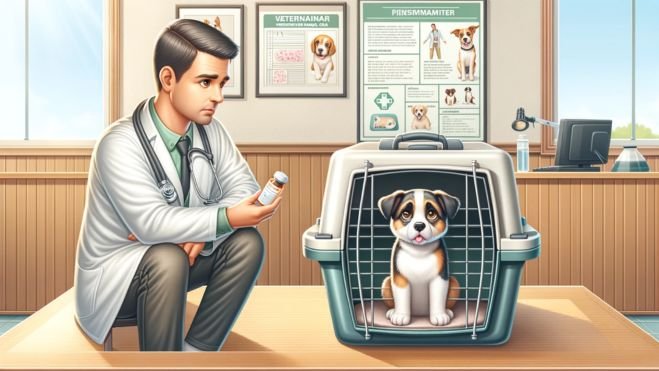
Traveling with that struggles with severe anxiety, can be really challenging. But don’t worry, I’ve been in your shoes and I’ve a couple of tips that might help.
If it gets really tough, you might want to consider medication. A trusted vet can suggest the right type of prescription anti-anxiety meds, sedatives, or tranquilizers that are safe and effective for your four-legged friend.
Remember to have a thorough discussion with your vet about the proper dosage and potential side effects.
You need to do this to make sure your pet stays safe, comfortable, and relaxed throughout the journey.
My colleague Debbie and I once traveled with a particularly anxious dog, and the right medication made a world of difference. It’s all about finding what works best for your pet’s specific needs.
I’ve gotta tell you, it’s not just about the meds. You have to test different routines and products to see what helps your pet feel more at ease.
Like we’ve said earlier, it might be a certain kind of toy, a special blanket, or even a specific travel carrier.
It’s all about trial and error, and finding that sweet spot that helps your pet feel safe and secure.
Prescription Anti-Anxiety Medications
When you have a dog that gets really anxious during flights, you might find yourself considering prescription anti-anxiety meds as a final solution. But, let me tell you, it’s super important to have a chat with your vet about potential side effects and the correct dosage before giving them to your beloved pet.
In some cases, vets might suggest a type of anti-anxiety medication known as benzodiazepines. These medications can help calm your dog during a flight. They essentially reduce their anxiety levels, making the journey less stressful for both of you.
However, these medications aren’t a quick fix. They have sedative effects and should be used responsibly. It’s crucial to only use them under strict veterinary supervision. They can have potential side effects and may interact with other medications your pet might be taking.
In cases where your pooch’s anxiety just won’t budge, even with all the soothing techniques, a chat with your vet about the possibility of using relaxation meds like sedatives or tranquilizers could be a lifesaver.
Safety is paramount here, folks. These meds can have side effects, so it’s crucial to only use them under your vet’s watchful eye. They’ll guide you on the right dosage and when to administer it.
I can’t emphasize enough how important it was to have our vet’s guidance during that stressful time. It ensured the safety of our furry friend during the flight and helped us avoid any potential side effects.
Are You Ready to Fly?
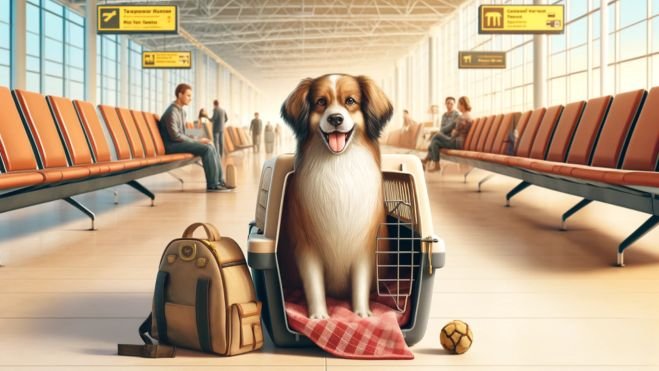
Having journeyed with my fair share of four-legged companions, I’ve found that every pooch is different.
Patience and understanding are key when figuring out what keeps them relaxed during a flight.
In my experience, the right preparation, natural calming techniques, and a nod from the vet can make all the difference in creating a positive travel experience for both you and your furry friend.


